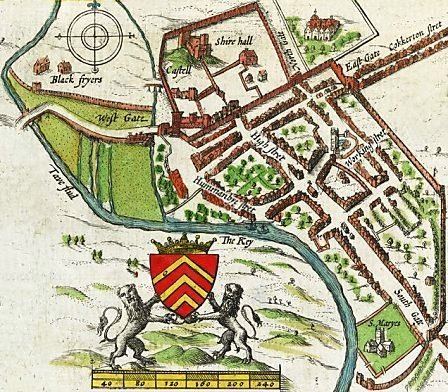Denomination Anglican Status Demolished Phone +44 29 2048 7777 | Country Wales Founded 1107 Closed Abandoned after 1701 | |
 | ||
Similar St John the Baptist Church, St Mary's Church - St Fagans, St Mary of the Angels Roman C, St German's Church, City United Reformed Church | ||
St Mary's Church (Eglwys Fair) was an Anglican church in Cardiff, Wales, which stood at the south end of the current St. Mary's Street, from 1107 until 1620. After severe flood damage it was abandoned in 1701 and later replaced at a different location in 1843.
Contents
Early history
St Mary's was founded as a Benedictine priory in the 1080s, by Robert Fitzhamon (also founder of Tewkesbury Abbey in 1092). However, the site next to the River Taff was a poor one, susceptible to both continual flooding and river erosion. Even after stabilising the foundations, bodies from burials would regularly be washed down the river. The abbey withdrew the monks in 1211.
Destruction
In 1607, the area of England and Wales bordering the Bristol Channel experienced a devastating flood, now believed to have been a tsunami. The Bristol Channel floods washed away much of St Mary's foundations and it slowly began to collapse.
In 1620, the decision was made to make St John's the main parish church, which was originally just an offshot development. The two churches were worked as one parish, with all burials and some services continuing at St Mary's.
In 1638, the vicar of St Mary's, William Erbery, was forced to resign, his curate Walter Cradock had his licence revoked, and senior members of the congregation were barred from the premises after they refused to read the Book of Sports. Erbery's other curate, William Wroth, eventually conformed. These people, together with others of a similar mind, formed the core of a congregation, that after the English Civil War and subsequent Restoration, in 1696 were granted land in Womanby Street by Alderman John Archer. This allowed them to build the first Trinity Church, later known as a Presbyterian chapel.
By 1678, with evidence from the visit of Francis Place and later essays from the Celtic scholar Edward Lhuyd, both described St Mary's as being in ruins. The tower collapsed in 1680 and the last recorded burial in the churchyard took place in 1698. The last service was held in a roofless ruin in 1701, after which St Mary's was abandoned.
Replacement and later developments
In 1843, John Crichton-Stuart, 2nd Marquess of Bute paid for the construction of the Church of St. Mary the Virgin and St. Stephen the Martyr, in Bute Street as a permanent replacement. The 1843 church was designed by John Foster of Liverpool. The east end (by J. D. Sedding) was added in 1884, later enlarged in 1907. Wall paintings decorate the chancel arch. The church is a Grade II listed building.
The River Taff was diverted in 1850 (by Isambard Kingdom Brunel) to create a site to build the Cardiff Central railway station, also resulting in the creation of Westgate Street.
The Prince of Wales theatre was built on the site of the old church. This is now the location of the current Prince of Wales public house.
